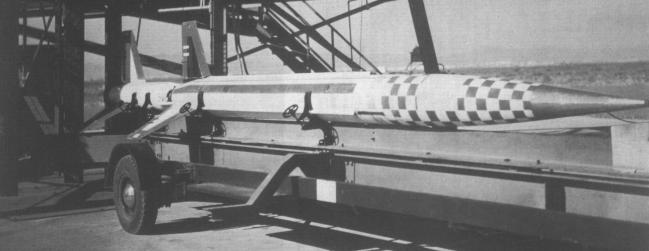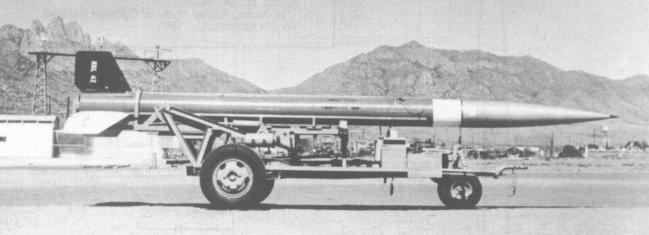Aerojet General RM-84/PWN-2 Aerobee-Hi
(and earlier Aerobee variants)
In the immediate postwar period (1946), the captured German A-4/V-2 rocket was used in the United States not only for general rocket research, but also for high-altitude scientific experiments. However, this large cumbersome rocket was far from the ideal for relatively low-cost sounding rockets, and as early as January 1946 it was planned to create a purpose-built research rocket. The new rocket was to be based on the RTV-G-1 WAC Corporal research vehicle, which was tested at that time by the U.S. Army. The sounding rocket program was managed by the U.S. Navy Bureau of Ordnance (BuOrd), and in May 1946, BuOrd awarded a development contract for the RTV-8 (changed to RTV-N-8 in early 1948) Aerobee to Aerojet General. The first live-firing of an Aerobee occurred in November 1947, and by 1950 the Aerobee was in wide use by U.S. military research agencies.
The Aerobee was a single-stage liquid-fueled spin-stabilized rocket, which used a solid-propellant rocket motor as a booster. Because initial acceleration was relatively slow, it was launched in a high launch tower, which guided the rocket until the fins would take effect. The booster was jettisoned after burnout 2.5 seconds into the flight. The original Aerobee could reach an apogee of about 120 km (75 miles) with a payload of about 68 kg (150 lb). The nose cone containing the telemetry transmitter and the scientific payload was recoverable and returned to earth on a parachute.
There were a multitude of versions of the basic Aerobee. The original RTV-N-8, which was also known by Aerojet's designation XASR-1, used an 11.5 kN (2600 lb) thrust sustainer. It was soon followed by the XASR-2, which was designated RTV-A-1 by the Air Force and RTV-N-10 by the Navy. The XASR-2 used helium pressurization instead of air pressurization for the sustainer engine, and first flew in late 1949. The RTV-A-1a/RTV-N-10a used an Aerojet AJ10-25 sustainer with 18 kN (4100 lb) thrust, but shorter duration. The USAF also tested a few examples each of the RTV-A-1b (using the original 11.5 kN engine with chemical pressurization), the RTV-A-1c (as -1a, but launched without booster) and the RTV-A-1d (using the 18 kN engine of the -1a with chemical pressurization, and launched without booster). Other Navy models were the experimental RTV-N-10b (using the AJ10-24 engine, a variant of the -10a's engine with a higher specific impulse) and the RTV-N-10c (production variant of the -10b, using an AJ10-27 sustainer). The USAF's production version of the AJ10-24/RTV-N-10b was the AJ10-34, which did not get any designation.
 |
| Photo: USAF |
| RTV-A-1 (X-8) |
In 1951, the USAF's RTV-A-1 rockets were redesignated in the X-8 series:
| Old Designation | New Designation |
|---|---|
| RTV-A-1 | X-8 |
| RTV-A-1a | X-8A |
| RTV-A-1b | X-8B |
| RTV-A-1c | X-8C |
| RTV-A-1d | X-8D |
The first major improvement of the basic Aerobee was the Aerobee-Hi, which was developed from late 1952 and first flew in 1955. It had a longer propellant tank, new materials in the rocket engine for higher efficiency, and larger fins for improved stability. Initially two different variants were built for USAF and U.S. Navy, the Air Force-Hi (which didn't use any formal designation, except for the general project designator MX-1961) and the RTV-N-13 (later RV-N-13) Navy-Hi. The Air Force-Hi could loft a payload of 68 kg (150 lb) to about 240 km (150 miles), while the slightly longer Navy-Hi could reach 270 km (170 miles). There were several different Aerobee-Hi sustainer engine configurations, known as AJ11-6, AJ11-18, AJ11-20, AJ11-21, AJ11-25 and AGVL-0113C/F/H/I. The variants of the Navy-Hi were designated RV-N-13a, RV-N-13b (with an AJ11-21 motor) and RV-N-13c. In 1959, the name Aerobee 150 was assigned by NASA to a "standarized" Aerobee-Hi, which was a slightly modified Air Force-Hi. The last of the variants of the original Aerobee was the Aerobee 150A, which was a 150 with changed internal tank arrangement and four instead of three fins on booster and sustainer.
 |
| Photo: U.S. Navy |
| RV-N-13 (PWN-2A) (without booster) |
In April 1959, the USAF, at the request of the Air Force Cambridge Research Center (AFCRC), allocated the formal reconnaissance missile designation XRM-84 to an Aerobee-Hi configuration with the Aerojet AJ11-21 sustainer. This was very similar (and possibly identical) to the RV-N-13b Navy-Hi. In June 1963 the XRM-84 was redesignated as PWN-2A, but use of the Aerobee family by the USAF ended at some time in the mid-1960s.
 |
| Photo: Aerojet General |
| Aerobee 150 (without booster) |
In total, more than 800 examples of the first Aerobee versions (basic Aerobee, Aerobee-Hi and Aerobee 150/150A) were built and flown by the U.S. military services and NASA between 1947 and 1985 (when the last Aerobee 150 was launched by NASA). It was the first American general purpose high-altitude sounding rocket. It's most serious drawback was the liquid-fueled sustainer engine, and the need for a relatively large launch tower. Therefore it was not suitable for mass firings (many rockets from a single location within a relatively short time frame) or for launches in remote locations or from ships. For these purposes, in the mid-1950s solid-fueled sounding rockets began to appear, which used many multi-stage combinations of surplus and new solid-rocket boosters. One of these, which was also used by the U.S. military, was the Nike-Cajun (XRM-85/PWN-3). The Aerobee itself was developed into several enlarged rockets like the Aerobee 170, Aerobee 300 and Aerobee 350.
Specifications
Note: Data given by several sources show slight variations. Figures given below may therefore be inaccurate!
Data for RTV-N-8, RTV-A-1a/RTV-N-10a, RV-N-13b (PWN-2A is similar), Aerobee 150:
| RTV-N-8 | RTV-A-1a / RTV-N-10a | RV-N-13b | Aerobee 150 | |
|---|---|---|---|---|
| Length (w/o booster) | 6.14 m (20 ft 1.8 in) | 7.58 m (24 ft 10.6 in) | 7.20 m (23 ft 7.6 in) | |
| Length (incl. booster) | 8.06 m (26 ft 5.3 in) | 9.44 m (30 ft 11.6 in) | 9.06 m (29 ft 8.6 in) | |
| Diameter | 38 cm (15 in) | |||
| Fin Halfspan | 79 cm (31 in) (fin tip to centerline) | |||
| Weight (without booster) | 485 kg (1070 lb) | 510 kg (1130 lb) | 680 kg (1500 lb) | 590 kg (1300 lb) |
| Booster: 260 kg (575 lb) | ||||
| Speed | 4850 km/h (3015 mph) | 4940 km/h (3070 mph) | 7440 km/h (4620 mph) | 6850 km/h (4260 mph) |
| Ceiling (68 kg (150 lb) payload) | 120 km (75 miles) | 270 km (170 miles) | 240 km (150 miles) | |
| Sustainer (liquid-fuel rocket) | Aerojet XASR-1; 11.5 kN (2600 lb) for 45 s |
Aerojet AJ10-25; 18 kN (4100 lb) for 32 s |
Aerojet AJ11-21; 18 kN (4100 lb) for 51 s |
Aerojet AJ11-6; 18 kN (4100 lb) for 42 s |
| Booster | Aerojet X103C10 (2.5KS18000) solid-propellant rocket; 80 kN (18000 lb) for 2.5 s | |||
Main Sources
[1] Frederick I. Ordway III, Ronald C. Wakeford: "International Missile and Spacecraft Guide", McGraw-Hill, 1960
[2] Norman J. Bowman: "The Handbook of Rockets and Guided Missiles", Perastadion Press, 1963
[3] Peter Alway: "Rockets of the World", Saturn Press, 1999
[4] Jay Miller: "The X-Planes, X-1 to X-45", Midland Publishing, 2001
[5] Department of Defense Missile Nomenclature Records
Back to Current Designations Of U.S. Unmanned Military Aerospace Vehicles
Back to Directory of U.S. Military Rockets and Missiles
Last Updated: 31 March 2004